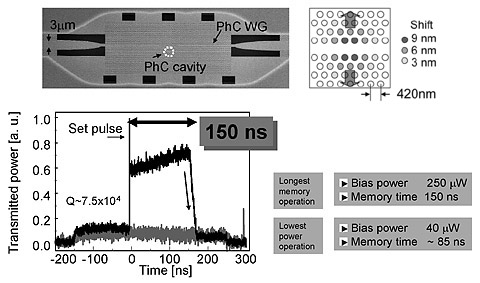Tomonari Sato2, Takaaki Kakitsuka2, and Masaya Notomi1
1Optical Science Laboratory, 2NTT Photonics Laboratories
We have focused on a resonant tunneling filter on a Si based photonic
crystal (PhC) platform where single-mode waveguides (WGs) are effectively
coupled with an ultrasmall cavity with a high Q factor. The photon density
in the cavity is extremely high owing to its small size and effective coupling
with PhC-WGs, and this results in a large optical nonlinearity that enables
us to realize all-optical memories with very low operating power [1]. However,
it is very difficult to achieve a long memory time for a Si based PhC because
of its small optical nonlinearity. In this work, we developed an InGaAsP
based PhC nanocavity and realized an all-optical bit memory that can operate
at very low power and achieve a long memory time.
Figure 1 shows the bit memory operation of the InGaAsP based PhC nanocavity
[2]. The initial state of the memory is OFF and it outputs a low level
signal (gray line). When a set pulse with a width of 100 ps is input from
the waveguide to write one bit of information, the memory turns ON and
outputs a high level signal (black line). The memory remains in the ON
state after the set pulse has been applied, which means that the bit information
is stored. The longest memory time is 150 ns, which is much longer than
that of a Si-PhC memory (2.5 ns). The minimum bias power for the memory
operation is 40 µW, which is ten times lower than for a Si-PhC and
around 100 times lower than that of a conventional optical memory based
on bistable lasers. This technology is expected to eliminate certain photonic
device bottlenecks such as the difficulty of dense integration on a chip
and the difficulty of achieving low power consumption in all-optical memories.
This work was supported by the National Institute of Information and
Communications Technology (NICT).
[1] T. Tanabe, et al., Opt. Lett., 30 (2005) 2575.
[2] A. Shinya, et al., CLEO/QELS2008, San Jose, U.S.A., May 2007.
 |
||
|